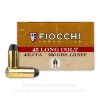Driftwood Johnson
Member
Here is how brass is turned into finished brass.
Let me/us know how they respond to that over on the IAA forum. Like I said above - I have neither the resources nor the inclination to support their conclusion..The folks over at IAA have concluded that the cannelure was put on smokeless revolver cartridges - when there were also black powder cartridges available in the same round, so people could tell them apart.
That doesn't hold water .........The differentiation at the time was in the primers: Copper primers denoted black powder, brass primers denoted semi-smokeless powder, and nickel primers denoted smokeless powder.
First, the caboose was for watching the train (from the little cupola thing on top), and to monitor train air pressure (air controls the brakes).
I did manage to learn that the .45 Long Colt was called the .45 Colt's for a long, long, long time - in both black powder & smokless.

Nope - price lists and catalogs from before the 1920's say otherwise.It has always been 45 Colt.
Hmm- curious - the Peter's catalogs also list primers - and all of them, smokeless or black powder, are all copper.That doesn't hold water .........The differentiation at the time was in the primers: Copper primers denoted black powder, brass primers denoted semi-smokeless powder, and nickel primers denoted smokeless powder.
Can you offer support for your claim?
It's Colt's - not Colt - not until into the 1920s does it change to Colt.
They drop the "apostrophe S".
Railways and Union Settle 35‐Year. Fireman Dispute - The New York Times (nytimes.com)Driftwood,
Fireman were on all trains ( don't quote me ) till the 80's because of the unions. Firemen were on the train to stoke the boilers on the steam loco's
Fireman were on all trains ( don't quote me ) till the 80's because of the unions. Firemen were on the train to stoke the boilers on the steam loco's

No - no - and no - from 1873 through 1919 - 46 years - that's a long time - the price lists and ammunition catalogs call it Colt's.I am pretty sure in regards to ammunition it has always been .45 Colt, not "Colt's" and definitely not "Long Colt". People incorrectly refer to the .45 Colt as the .45 Long Colt.
Well - I wasn't asking you for your sources - but - since you mention not relying on one website, did YOU bother to go to that website and download the prices lists and catalogs - to see for yourself - that it's "Colt's"?Only 40 years of experience shooting, loading, and reading about the cartridge. Not relying on one websi





IMHO- splitting hairs about a name for the historic cartridge we now call 45 Colt is an adolescent activity.
You think that's dumb? How about a .40 caliber cartridge that holds 38 grains of powder being called the .38-40 instead of the .40-38?The must be lot of really dumb, slow minded folks in the handgun world. They get the 45 Colt cartridge confused with the 45 Schofield, so the name of the original cartridge had to be changed to 45 Long Colt. Yet the Schofield round, which was also known as the 45 S&W, was never called the 45 Short. Curious!
Dave








How about a .40 caliber cartridge that holds 38 grains of powder being called the .38-40 instead of the .40-38?
